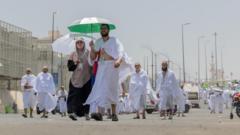The Hajj pilgrimage has officially begun, attracting more than 1.4 million Muslims to the holy city of Mecca, Saudi Arabia, as the nation braces for scorching temperatures that could soar to 44 degrees Celsius (111 degrees Fahrenheit). In response to a tragic incident last year where approximately 1,300 individuals died, predominantly from heat-related causes, the Saudi government is enforcing strict measures to protect pilgrims.
To combat the intense heat, authorities have planted thousands of trees and installed over 400 cooling units aimed at providing respite from the oppressive climate. They have also implemented regulations prohibiting the entry of children under 12, in a bid to safeguard the most vulnerable. Furthermore, those attempting to participate in the Hajj without official registration may face significant penalties, including fines of up to $5,000 and potential bans from re-entering the kingdom for up to ten years. In recent reports, officials have disclosed that they have prevented more than 269,000 unauthorized entrants from accessing Mecca.
The previous year's fatalities predominantly involved unregistered pilgrims lacking access to air-conditioned accommodations and proper transport during a heatwave that peaked at an alarming 51 degrees Celsius. Many of these individuals could not afford the often exorbitant official Hajj packages, which range from $4,000 to $20,000 depending on their country and preferences. Instead, they secured entry through tourist or visitor visas.
As millions embark on the spiritual journey, pilgrims engage in numerous sacred rituals. Men don two simple white garments as they enter the Ihram state, while women wear modest attire. The journey includes circling the Kaaba within Mecca's Grand Mosque—considered Islam's holiest site—and traversing between the hills of Safa and Marwa.
To mitigate potential health risks, the Saudi health ministry advises pilgrims to adhere to specific guidelines aimed at minimizing sun exposure, especially between the hours of 10 AM and 4 PM. Recommendations include the use of sun umbrellas for shade and maintaining hydration levels.
Officials have reported a significant increase in shaded areas, expanding by an impressive 50,000 square meters (12 acres). Moreover, enhanced roadways made from rubberized and cooled materials have been constructed to reduce heat exposure, with artificial intelligence deployed to monitor crowds via a fleet of drones.
The Hajj pilgrimage remains one of the Five Pillars of Islam, requiring every Muslim to undertake it at least once if physically able and financially capable. As the faithful gather to fulfill this sacred duty, safety precautions are at the forefront to ensure the well-being of all participants.
To combat the intense heat, authorities have planted thousands of trees and installed over 400 cooling units aimed at providing respite from the oppressive climate. They have also implemented regulations prohibiting the entry of children under 12, in a bid to safeguard the most vulnerable. Furthermore, those attempting to participate in the Hajj without official registration may face significant penalties, including fines of up to $5,000 and potential bans from re-entering the kingdom for up to ten years. In recent reports, officials have disclosed that they have prevented more than 269,000 unauthorized entrants from accessing Mecca.
The previous year's fatalities predominantly involved unregistered pilgrims lacking access to air-conditioned accommodations and proper transport during a heatwave that peaked at an alarming 51 degrees Celsius. Many of these individuals could not afford the often exorbitant official Hajj packages, which range from $4,000 to $20,000 depending on their country and preferences. Instead, they secured entry through tourist or visitor visas.
As millions embark on the spiritual journey, pilgrims engage in numerous sacred rituals. Men don two simple white garments as they enter the Ihram state, while women wear modest attire. The journey includes circling the Kaaba within Mecca's Grand Mosque—considered Islam's holiest site—and traversing between the hills of Safa and Marwa.
To mitigate potential health risks, the Saudi health ministry advises pilgrims to adhere to specific guidelines aimed at minimizing sun exposure, especially between the hours of 10 AM and 4 PM. Recommendations include the use of sun umbrellas for shade and maintaining hydration levels.
Officials have reported a significant increase in shaded areas, expanding by an impressive 50,000 square meters (12 acres). Moreover, enhanced roadways made from rubberized and cooled materials have been constructed to reduce heat exposure, with artificial intelligence deployed to monitor crowds via a fleet of drones.
The Hajj pilgrimage remains one of the Five Pillars of Islam, requiring every Muslim to undertake it at least once if physically able and financially capable. As the faithful gather to fulfill this sacred duty, safety precautions are at the forefront to ensure the well-being of all participants.





















